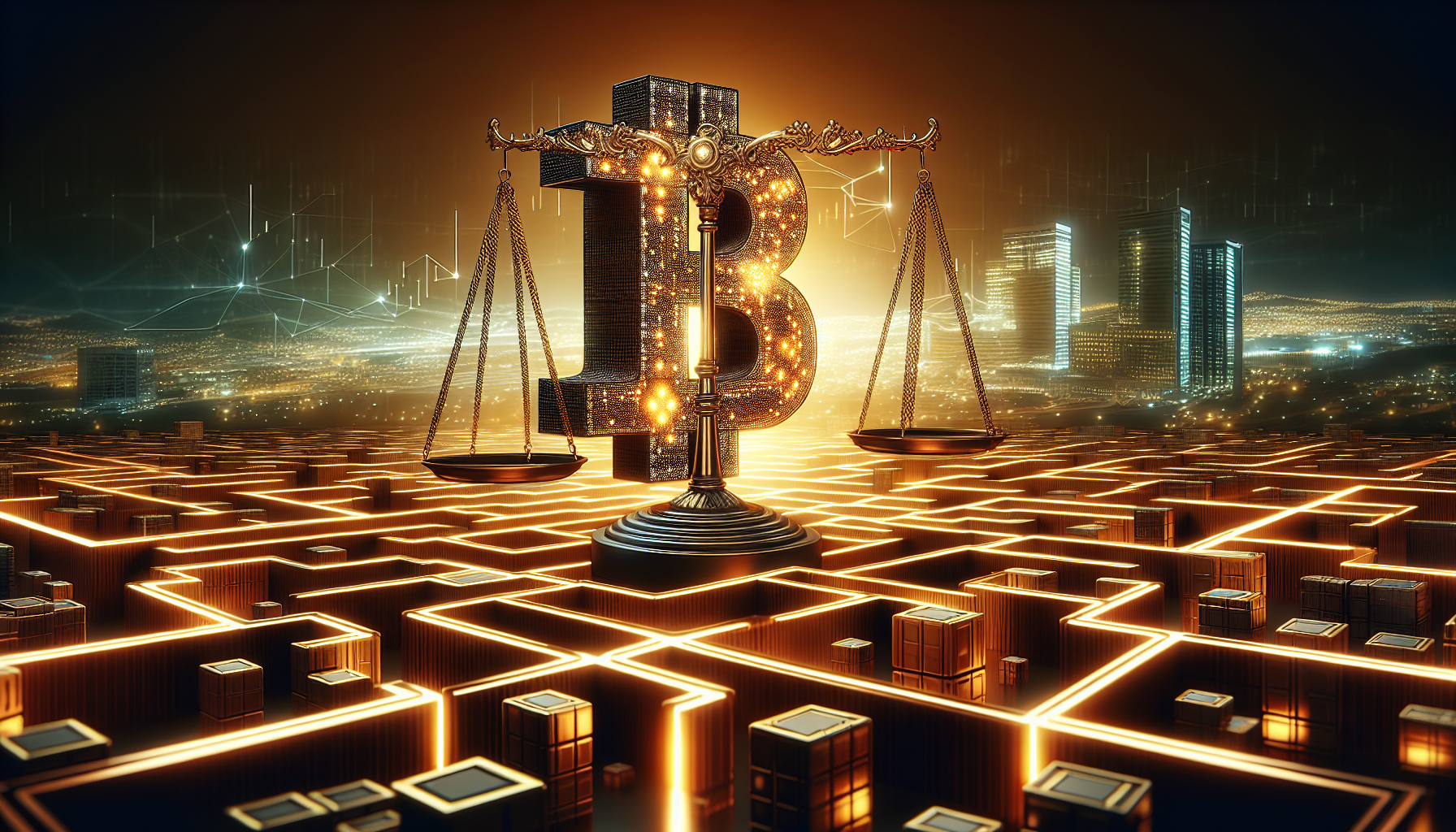In a world where blockchain technology is pervading every facet of our lives, from finance to healthcare, and even governance, understanding blockchains laws becomes a necessity. But, are we ready to navigate the evolving regulatory landscape of this transformative technology?
Key Takeaways
- Navigating the legal landscape of blockchain technology requires an understanding of local laws and regulations.
- Key challenges include jurisdictional issues, smart contract enforceability, data privacy and protection, securities laws for digital assets, AML/KYC requirements, governance structure & liability allocation.
- Best practices to ensure compliance include risk assessment & engaging experts in legal & regulatory matters.
Blockchain and the Legal Landscape

Envision a world where all transactions, agreements, contracts, and even votes are securely and efficiently recorded and verified – that’s the potential of blockchain technology. Yet, this technological revolution brings with it a multitude of legal challenges, including a significant lack of regulatory clarity. Imagine navigating a labyrinth without a map; this is the current scenario. So, the question arises, how do we navigate this?
Both network operators and participants utilizing distributed ledger technology bear the responsibility for ensuring their blockchain solution aligns with laws and regulations. However, this task is easier said than done. The current regulatory landscape is a patchwork of outdated laws that fail to address the unique challenges posed by blockchain technology. This has left market participants groping in the dark, struggling to understand the application of regulations and identify the affected participants.
The lack of regulatory clarity also stymies the broader adoption of blockchain technology. It’s like trying to build a skyscraper on a shaky foundation. Without clear regulations, businesses face legal uncertainties and compliance challenges that can undermine the benefits of utilizing blockchain technology. So, achieving regulatory clarity is not merely a legal necessity, but a prerequisite for the widespread adoption of blockchain technology.
The Need for Regulatory Clarity
Why does the adoption of blockchain technology hinge on regulatory clarity? The nature of blockchain itself holds the answer. The decentralized nature and global reach of blockchain present a unique set of legal uncertainties and compliance challenges, akin to trying to solve a puzzle with mismatched pieces.
Take, for instance, the issue of digital tokens. These tokens, which are commonly based on blockchain platforms, give rise to legal uncertainties about their nature. Are they securities, commodities, or something else entirely? In the absence of clear regulations, market participants are left to their own devices to interpret and comply with a hodgepodge of rules that may or may not apply to their operations involving digital token.
Therefore, the bridging of regulatory gaps and attainment of regulatory clarity are vital for blockchain technology to reach its full potential. In the same way a ship needs a compass for navigation, businesses require clear and consistent regulations to steer their blockchain operations.
Global Differences in Blockchain Laws
Shifting our focus to the international stage, we find a regulatory landscape for blockchain technology as diverse as the nations themselves. Each country possesses its unique set of blockchain laws and regulations, reflecting its individual culture and traditions.
Take the United States, for example. The regulatory approach to virtual currency and blockchain technology varies widely among U.S. states. Some states, like Wyoming, have been more welcoming, while others have been more cautious, requiring licensing for certain digital asset businesses, especially those that sells convertible virtual currency. This patchwork of state laws can create a confusing maze for businesses trying to navigate the U.S. regulatory landscape.
And it’s not just the United States. Countries around the world have their own unique approaches to regulating blockchain technology, often reflecting their own socio-economic realities and regulatory philosophies. This means that businesses, such as virtual currency exchange platforms, must not only understand the specific legal requirements of each jurisdiction where they operate, but also adapt their operations to comply with these requirements.
Key Legal Issues with Blockchain Technology

As we explore further into the legal maze of blockchain technology, we encounter several significant legal issues. These issues, much like the complex twists and turns of a Rubik’s cube, are intricately interconnected.
One of the most pressing legal issues is jurisdictional challenges. The decentralized nature of blockchain, which allows nodes to be situated in various locations across the globe, gives rise to intricate jurisdictional concerns. Every transaction has the potential to be subject to the jurisdiction of each and every node within the network, creating a complex web of legal considerations.
Smart contracts, the heart of many blockchain networks, also present legal challenges. While these self-executing contracts offer a myriad of benefits, including efficiency and automation, they may pose legal enforceability challenges if they fail to meet the traditional requirements of a legal contract.
Last but not least, data privacy and protection concerns weigh heavily on the adoption of blockchain technology. The immutability of the blockchain, one of its key strengths, may conflict with data protection regulations.
Jurisdictional Challenges
The jurisdictional challenges presented by the decentralized nature of blockchain technology are akin to navigating a ship in international waters. As blockchain networks often span multiple jurisdictional boundaries, every transaction has the potential to fall under the jurisdiction of each and every node within the network. This presents a legal quandary, akin to a ship being subject to the laws of every country whose waters it traverses.
To complicate matters further, certain legal and regulatory regimes, such as the European Union’s General Data Protection Regulation (GDPR), have extra-territorial effects that can impact blockchain operations. These regulations may apply to companies operating across multiple jurisdictions, ensnaring blockchain-based businesses in a complex web of compliance requirements.
Navigating these jurisdictional waters requires both a deep understanding of the legal landscape and a strategic approach. Just as a ship needs a skilled captain to steer it safely through international waters, businesses need to meticulously examine local laws and regulations to ensure compliance.
Smart Contracts and Enforceability
Smart contracts are the cornerstone of many blockchain applications. Like a Swiss Army knife, they offer a multitude of features – from automating transactions to enforcing contractual agreements. However, these versatile tools also pose legal enforceability challenges.
At the heart of the matter is the question of whether smart contracts meet the traditional requirements of a legal contract, such as offer, acceptance, consideration, and intention to create legal relations. This is a complex question, as smart contracts differ from traditional contracts in several key ways. For instance, they are self-executing contracts with the terms of the agreement written into lines of code, whereas traditional contracts are legally binding agreements written on paper or in a digital format.
Further complicating matters is the fact that the legal enforceability of smart contracts can vary internationally. For instance, a smart contract utilized as an international sales contract, encompassing a complete agreement within its code, is recognized under the Convention on Contracts for the International Sale of Goods (CISG).
Data Privacy and Protection
As we delve further into the legal complexities of blockchain technology, we encounter the contentious issue of data privacy and protection. This issue is like a double-edged sword, with the immutability of the blockchain both bolstering data security and potentially conflicting with data protection regulations.
Consider, for example, the European Union’s General Data Protection Regulation (GDPR). This regulation grants individuals the power to control their personal data, contradicting the immutable nature of blockchain and making it difficult to modify or erase data. This conflict between data privacy laws and the features of blockchain technology presents a significant challenge for businesses using blockchain.
However, it’s not all doom and gloom. By achieving a balance between the benefits of blockchain technology, such as transparency and immutability, and the observance of data privacy laws, businesses can uphold individual rights and ensure regulatory compliance.
Blockchain Regulation in the Financial Sector

Turning our focus to the financial sector, we observe the disruptive wave of blockchain technology. Visualize a tsunami heading towards a city, where the city represents the financial sector and the tsunami symbolizes blockchain technology. The regulatory challenges then, can be viewed as the city’s barricades against this tsunami.
Securities laws, including federal securities laws, exert a significant influence on the use of blockchain technology in the financial sector. These laws govern the issuance, trading, and transfer of securities, including digital assets and tokens based on blockchain platforms. Adhering to securities laws is essential for companies leveraging blockchain technology to ensure compliance with the necessary regulatory standards.
However, the financial sector also encounters unique regulatory obstacles when engaging with blockchain technology. These include financial and professional regulation challenges, such as financial stability risks, regulatory gaps, difficulties in combating money laundering and terrorist financing on public blockchains, and the potential for regulatory arbitrage by firms operating in less-regulated jurisdictions.
Securities Laws and Digital Assets
When we talk about the intersection of securities laws and digital assets, we’re essentially discussing how the old world of finance meets the new world of blockchain. It’s akin to a crossroads where the past meets the future.
In the eyes of the Securities and Exchange Commission (SEC), a token issued in an Initial Coin Offering (ICO) may be considered a security if it satisfies certain criteria of the Howey test, even if it is deemed to have ‘utility’. This is like classifying a new species of animal based on its characteristics and behavior.
On the other hand, the Commodity Futures Trading Commission (CFTC) considers tokens issued in an ICO as commodities. This difference in perspectives between the SEC and CFTC, as well as the involvement of the Financial Stability Oversight Council, creates a complex regulatory landscape that businesses must navigate when dealing with digital assets.
Anti-Money Laundering (AML) and Know Your Customer (KYC) Requirements
AML and KYC requirements form the bedrock of regulatory compliance in the financial sector, akin to the foundation of a building. Just as the stability of a building depends on the strength of its foundation, the legitimacy of a blockchain network hinges on its compliance with AML and KYC requirements.
For instance, all transactions involving ‘value that substitutes for currency,’ such as digital currency, convertible virtual currency, and fiat currency, are subject to reporting requirements and money transmitter registration. This is akin to mandatory customs declarations when crossing international borders with physical currency.
Moreover, businesses offering financial services related to digital currencies, such as virtual currency exchanges and financial institutions, are required to implement robust AML programs. These programs encompass various components, including:
- Written policies
- Procedures
- Internal controls designed to ensure continuous compliance
- The appointment of a compliance officer responsible for overseeing day-to-day compliance with the program and Bank Secrecy Act (BSA) requirements.
Establishing a Blockchain Network: Legal Considerations

Building a blockchain network shares similarities with constructing a house. Both require careful planning, a solid foundation, and meticulous attention to detail. Setting up a blockchain network necessitates the careful consideration of various legal aspects, such as governance structure, liability allocation, and intellectual property rights.
The governance structure of a blockchain network exerts a substantial influence on its legal aspects. It serves as the foundation for addressing conflicts and setting forth guidelines and regulations within the network. It’s akin to the blueprint of a house, providing a detailed plan for its construction.
On the other hand, liability allocation within the network is akin to the division of responsibilities among the various contractors and subcontractors building the house. It’s about establishing accountability for the activities conducted on the blockchain and ensuring that all participants comprehend their legal responsibilities.
Governance Structure and Legal Documentation
In a blockchain network, the governance structure serves as the compass that guides the functioning of the network. It encompasses the following:
- The rules and procedures that govern the blockchain ecosystem
- The process of decision-making
- Conflict resolution
- Implementation of network changes
Think of it as the constitution of a country, providing a framework for how the country is governed. Just as the constitution sets out the powers of the legislative, executive, and judicial branches of government, the governance structure of a blockchain network establishes the decision-making procedures and rules that govern the network.
Alongside the governance structure, legal documentation plays a pivotal role in the functioning of a blockchain network. This documentation extends beyond legal compliance to consider the specific rules and requirements of the blockchain network, akin to a user manual for a complex piece of machinery. It establishes effective governance and addresses regulatory challenges within the blockchain technology space.
Liability Allocation
The allocation of liability in a blockchain network is a complex task, akin to solving a jigsaw puzzle. It requires a clear understanding of the intricacies of the network, as well as the roles and responsibilities of the various participants.
This task is made even more complex by the decentralized nature of blockchain. Without a central authority to take responsibility for the network’s operations, it’s crucial to establish clear guidelines and regulations to allocate liability effectively.
Failing to allocate liability adequately can lead to confusion and potential legal conflicts among users, developers, and stakeholders. Just as a jigsaw puzzle is incomplete without all its pieces, a blockchain network cannot function effectively without a clear allocation of liability.
Intellectual Property Rights
Intellectual property rights play a crucial role in the establishment and operation of a blockchain network, much like a secret recipe is vital to a restaurant’s success. They provide legal protection for the development, dissemination, and monetization of technological advancements, ensuring that developers, creators, and network participants retain control over the use of their contributions.
Blockchain technology, with its potential to significantly impact intellectual property law, offers a more streamlined and effective method for registering trademarks, designs, and patents. It can enhance the management of intellectual property rights by creating transparent and unchangeable records of ownership and transactions.
However, protecting intellectual property rights in the blockchain space is not without its challenges. Developers and IP owners must meticulously assess their intellectual property strategy, customizing their approach to align with the intricacies of blockchain technology.
Blockchain Adoption: Navigating Jurisdictional Issues

As we further traverse the intricate legal landscape of blockchain technology, we come across the challenge of handling jurisdictional issues. This aspect is crucial for blockchain adoption, especially when dealing with decentralized digital identities and Decentralized Autonomous Organizations (DAOs).
Decentralized digital identities, which allow individuals to have control and ownership of their identity information, face legal obstacles within the framework of current laws and regulations. It’s akin to driving a futuristic car on roads designed for horse-drawn carriages.
Similarly, Decentralized Autonomous Organizations (DAOs), which are online, digital entities that function through the implementation of pre-coded rules maintained on a blockchain, face legal challenges due to their unique structure and operation. It’s like trying to fit a square peg into a round hole.
Decentralized Digital Identities
Decentralized digital identities, which provide individuals with control and ownership of their identity information, are a revolutionary concept in identity management. However, they face significant legal obstacles, akin to a ship navigating through treacherous waters.
These challenges stem from the fact that current laws and regulations are primarily designed for centralized digital identity systems. This makes it difficult to accommodate the unique features of decentralized digital identities, such as the ability for individuals to manage and share their data while retaining control over it.
Navigating these legal waters requires a deep understanding of the legal landscape and a strategic approach. Just as a ship needs a skilled captain to steer it safely through treacherous waters, businesses need to meticulously examine local laws and regulations to ensure compliance.
Decentralized Autonomous Organizations (DAOs)
Decentralized Autonomous Organizations (DAOs) represent a new paradigm in organizational structure. They are akin to a self-driving car, operating autonomously based on pre-set rules and without the need for human intervention. However, this unique structure presents significant legal challenges.
The legal status or liability of a DAO is determined by its structure and the jurisdiction in which it operates. This can be as complex as navigating a maze, with each turn representing a different legal challenge.
Despite these challenges, DAOs offer exciting potential for the future of organizational structure. With careful navigation of the legal landscape, DAOs could represent a new frontier in the way we organize and operate businesses.
Best Practices for Blockchain Compliance
Much like a ship requires a compass for navigation, businesses need best practices to steer through the complexity of blockchain compliance. These practices aid businesses in risk mitigation and in ensuring adherence to legal and regulatory norms.
One of the recommended best practices for ensuring compliance with blockchain technology is to adhere to smart contract security best practices. This includes engaging in secure software development and conducting thorough testing of smart contracts before deployment.
Another crucial best practice is to conduct individual risk assessments. This involves gathering and validating necessary information for compliance purposes, and assessing the risks associated with specific blockchain projects or applications.
Assessing Industry/Product Risks
Assessing industry and product-specific risks is akin to a ship’s captain studying weather patterns and sea conditions before setting sail. It is a crucial step in understanding the legal and regulatory landscape of a particular blockchain project or application.
The first step in evaluating product-specific risks in blockchain projects is to conduct a comprehensive risk assessment. This involves examining different aspects of the project, from the technical implementation of the blockchain technology to the legal and regulatory risks specific to the product or industry.
Another important step is to review the transactions on the blockchain. This can help identify potential risks and anomalies that may indicate fraudulent or illegal activities. Just as a ship’s captain keeps a close watch on the horizon for signs of stormy weather, businesses need to closely monitor their blockchain operations for signs of potential risks.
Engaging Legal and Regulatory Experts
Just as a ship needs a skilled captain to navigate the open seas, businesses need the guidance of legal and regulatory experts to navigate the complex world of blockchain laws and regulations. These experts can help businesses understand the legal implications of using blockchain technology, ensure compliance with relevant laws and regulations, and protect their legal interests.
Legal and regulatory experts can also provide valuable insights and guidance on the ever-changing regulatory landscape. Just as a ship’s captain needs to stay updated on changing weather patterns and sea conditions, businesses need to stay updated on the latest legal and regulatory developments related to blockchain technology.
Moreover, legal and regulatory experts can help businesses identify and address potential legal and regulatory risks. Just as a ship’s captain needs to be prepared for potential storms and other hazards, businesses need to be prepared for potential legal and regulatory challenges that may arise in their use of blockchain technology.
Summary
Sailing through the vast sea of blockchain laws and regulations is a complex journey. It requires a deep understanding of the technological landscape, a keen awareness of the ever-changing legal and regulatory environment, and the guidance of skilled legal and regulatory experts. But, with careful navigation and the right resources, businesses can successfully chart their course in the world of blockchain technology, ensuring compliance and mitigating risks.
Frequently Asked Questions
What is blockchain in cyber law?
Blockchain is a decentralized digital ledger that enables secure, transparent, and immutable transactions. It has become an integral part of cyber law in its ability to increase trust in digital interactions.
Is the blockchain code the law?
Despite being based on publicly available programing code and laissez-faire contract theory, the blockchain code is not legally binding and thus cannot be considered as law.
What crimes are in blockchain?
Blockchain-based crimes include money laundering, financial sanctions evasions, bribery and embezzlement. These crimes involve the transmission of monetary value using cryptocurrency.
How are Blockchains protected?
Blockchain technology is secured with cryptography and a consensus system such as proof of work. It employs asymmetric keys and decentralization principles to ensure trust in transactions, and utilizes cryptography to protect its records from being altered or destroyed. Additionally, permissioned blockchains require each node to be approved before joining.
What are the key legal issues associated with blockchain technology?
The key legal issues associated with blockchain technology involve jurisdictional challenges, the enforceability of smart contracts, and data privacy and protection.


